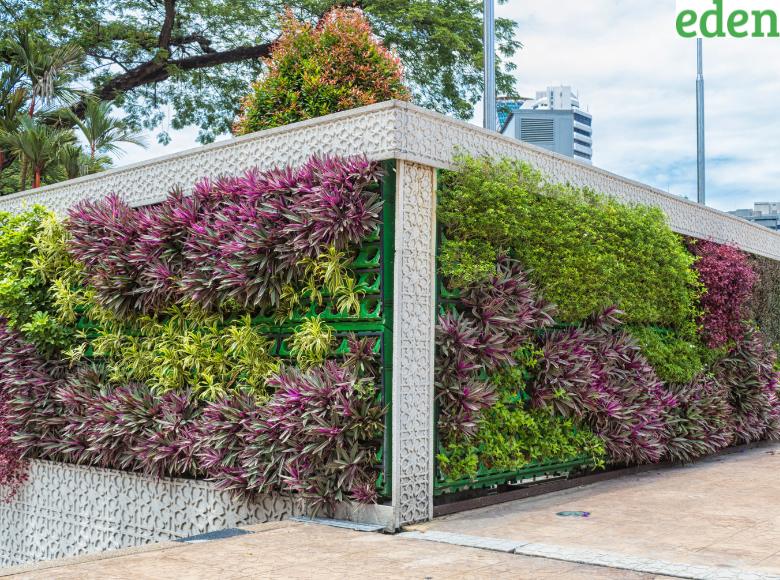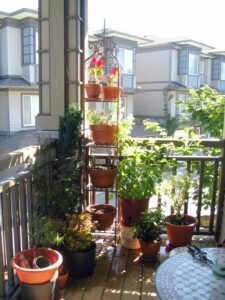Innovative Concept of Vertical Gardening
Vertical gardening is an innovative approach to maximizing green spaces in urban settings. This creative solution addresses the challenges of limited horizontal space in cities by utilizing structures such as vertical planters to create lush greenery on bare walls. The concept draws inspiration from ancient practices like the Hanging Gardens of Babylon, while adapting to the needs of modern urban dwellers.
In recent years, the rise of vertical gardening has been fueled by a growing population in urban areas and an increased focus on sustainable solutions. This trend is supported by the environmental benefits it offers, such as improved air quality, urban biodiversity, and mitigation of the heat island effect. By mastering vertical gardening techniques and using efficient drip irrigation systems, urban dwellers can transform their living spaces into green oases.
Professional installation by experts like Jonathan Robert Landscapes can provide a comprehensive guide on choosing the right plants and maintaining vertical gardens. These urban sanctuaries not only enhance the appeal of urban outdoor areas but also contribute to creating a greener city for all to enjoy. The innovative concept of vertical gardening is a great choice for those seeking to make a significant impact on their urban surroundings.
Benefits of Vertical Gardening
Vertical gardening offers a plethora of benefits that cater to the needs and constraints of urban dwellers. One of the most prominent advantages is its ability to maximize air quality in urban spaces. By introducing green spaces on structures like walls and fences, vertical gardens can act as natural air purifiers, filtering out pollutants and providing a breath of fresh air in crowded city environments.
Furthermore, vertical gardening is a practical solution for small spaces, making it ideal for urban dwellers who lack traditional gardening areas. These gardens serve as green sanctuaries in the midst of concrete jungles, offering a connection to the natural world and a retreat from the hustle and bustle of city life.
In addition to the aesthetic appeal of lush greenery, vertical gardens play a significant role in combating the heat island effect in urban areas. By covering structures with plant life, these gardens help cool the surrounding environment and reduce the overall temperature in urban settings.
Moreover, vertical gardening contributes to environmental benefits by promoting urban biodiversity and supporting sustainable solutions for food production. With the right plants and drip irrigation systems, these gardens can efficiently grow produce even in limited spaces, offering urban dwellers a chance to cultivate their own green oasis.
In recent years, the rise of vertical gardening has sparked current trends towards more innovative approaches to maximizing vertical oases in urban outdoor areas. From professional installations to comprehensive guides on mastering vertical gardening, there are now various techniques available to help urban residents create their own vertical planters and contribute to a greener city.
Overall, the appeal of vertical gardening lies in its creative solutions for utilizing vertical space and transforming bare walls into thriving hanging gardens of Babylon. By offering practical and aesthetically pleasing solutions, vertical gardening presents urban dwellers with a unique opportunity to enhance their living spaces while making a positive impact on the environment.
Importance of Vertical Gardening in Urban Settings
Vertical gardening is a revolutionary approach to cultivating plant life in a vertical direction, making use of structures like walls or pillars to create lush greenery in limited urban settings. This innovative technique has gained significant traction in recent years due to its ability to efficiently maximize green spaces in densely populated urban areas, where horizontal space is a premium commodity.
Urban settings often suffer from a lack of green spaces, which can have adverse effects on the environment and the well-being of urban dwellers. Vertical gardening offers a creative solution to this issue by transforming bare walls or unused vertical surfaces into green sanctuaries, providing urban residents with a connection to the natural world within their living spaces.
One of the key benefits of vertical gardening in urban settings is its contribution to improving air quality and reducing the heat island effect commonly found in cities. By covering vertical surfaces with plants, vertical oases are created that not only add beauty to urban outdoor areas but also help to filter air pollutants and cool surrounding temperatures. Additionally, vertical gardening can promote urban biodiversity by attracting birds, insects, and other wildlife to these green oases.
Furthermore, vertical gardening allows for food production in urban environments, offering sustainable solutions for growing population centers. By utilizing drip irrigation systems and selecting the right plants, urban gardeners can effectively cultivate a variety of crops in vertical planters, contributing to a greener, more self-sufficient city.
In conclusion, vertical gardening plays a significant role in the greening of urban spaces and offers solutions to the environmental challenges faced by cities. As the appeal of vertical gardening continues to rise, it is essential for urban planners, landscapers, and residents to consider mastering vertical gardening techniques to create a more sustainable and vibrant urban environment.
Practical Tips for Vertical Gardening
Starting Tips for Vertical Gardening
When venturing into the realm of vertical gardening, selecting the ideal location is paramount. Opt for spots that receive an adequate amount of sunlight, typically at least six hours per day for most plants to thrive. This could be a balcony railing, a sunlit wall, or even a specially designed vertical structure. Be mindful of the orientation of your chosen area, as different plants have varying light requirements – some thrive in direct sunlight, while others prefer partial shade.
Suitable plant selection is another crucial aspect to consider. Choose plants that are well-suited for vertical growth, such as vine crops like tomatoes, cucumbers, or beans. Additionally, opt for compact varieties of herbs, flowers, and leafy greens that don’t require extensive root systems. Succulents are also a great choice for vertical gardening due to their low maintenance requirements.
In terms of irrigation, consider installing drip irrigation systems to ensure your vertical garden receives adequate water without the risk of overwatering or underwatering. This method not only conserves water but also promotes healthy plant growth by delivering moisture directly to the roots.
By carefully selecting the right location, choosing suitable plants, and implementing efficient irrigation methods, you can set a solid foundation for mastering the art of vertical gardening in urban spaces. This innovative approach not only adds a touch of lush greenery to your living environment but also contributes to the greening of urban areas and offers sustainable solutions for urban dwellers looking to create their own green oasis.
Creative Ideas for Vertical Gardening
Urban spaces are constantly evolving to meet the needs of a growing population, and vertical gardening has emerged as an innovative approach to add lush greenery to urban settings. One creative solution for implementing vertical gardening is through the use of living walls. These structures not only add beauty to otherwise bare walls but also contribute to the overall appeal of urban spaces by providing a green sanctuary in the midst of concrete jungles.
Hanging planters are another great choice for urban dwellers looking to maximize their green spaces. By using vertical planters, urban residents can make the most of limited floor space and create a green oasis in their living areas. Professional installation of such structures can ensure that the right plants are chosen and that sustainable solutions like drip irrigation systems are put in place to maintain the lush greenery.
In recent years, the rise of vertical gardening has played a significant role in promoting urban biodiversity and combating the heat island effect in cities. By mastering vertical gardening techniques, such as those showcased in case studies like Jonathan Robert Landscapes’ projects in Urban Ottawa, urban areas can transform into vibrant ecosystems that benefit both the environment and the residents. Vertical oases offer solutions for creating greener cityscapes that blend harmoniously with the natural world while improving air quality and enhancing the overall quality of urban living.
Addressing Limited Space with Vertical Gardening
Vertical gardening creatively tackles the challenge of limited space in urban gardening by maximizing the use of vertical space rather than expanding horizontally. This innovative approach allows urban dwellers to bring greenery and plant life into their living spaces, even with minimal floor space available. By utilizing structures such as vertical planters or hanging gardens, vertical gardening transforms bare walls into lush green sanctuaries, effectively turning urban outdoor areas into green oases.
One of the key appeals of vertical gardening lies in its ability to offer solutions for urban areas facing constraints such as the heat island effect and limited green spaces. In recent years, the rise of vertical gardening has played a significant role in enhancing urban biodiversity and improving the environmental benefits of city living. Through the use of efficient drip irrigation systems and the careful selection of the right plants, vertical gardening presents a sustainable solution for urban populations looking to engage in food production or simply create a greener cityscape.
By mastering various techniques and seeking professional installation services from companies like Jonathan Robert Landscapes, urban residents can turn their urban settings into vibrant vertical oases. Case studies from urban centers like Ottawa highlight the success of vertical gardening in transforming urban landscapes and offering a comprehensive guide for those looking to delve into this creative solution. Overall, vertical gardening represents a comprehensive and efficient way to make the most out of limited urban space while reconnecting with the natural world in urban environments.
Benefits and Impact of Vertical Gardening
Benefits of Vertical Gardening in Facilities
Incorporating vertical gardening into facilities offers a multitude of benefits for urban settings. One significant advantage is that it allows for the maximization of limited space in densely populated areas. For urban dwellers who may lack ample horizontal space, vertical gardening provides a creative solution to introduce greenery into their living spaces. By transforming bare walls or structures into lush vertical oases, facilities can create a green sanctuary within urban environments.
Moreover, vertical gardening contributes to improving air quality and mitigating the heat island effect often experienced in cities. The presence of plant life in vertical gardens helps to filter pollutants and particulate matter from the air while also reducing overall temperatures through evapotranspiration. This innovative approach not only enhances the aesthetics of urban spaces but also plays a significant role in promoting environmental benefits and urban biodiversity.
Additionally, incorporating vertical gardening into facilities supports food production in urban areas, offering sustainable solutions for growing populations. By utilizing drip irrigation systems and selecting the right plants for vertical planters, facilities can master the art of vertical gardening to cultivate a variety of crops. Such green spaces not only enhance the appeal of urban living but also provide urban dwellers with access to fresh produce, promoting a greener and healthier city overall.
In recent years, the rise of vertical gardening has become a current trend in urban landscaping, with professional installations by companies like Jonathan Robert Landscapes showcasing the efficiency and beauty of this approach. By offering solutions for maximizing floor space and creating green oases in urban outdoor areas, vertical gardening has become a comprehensive guide for transforming urban spaces into vibrant and sustainable environments.
Role in Sustainability and Biophilic Design
Vertical gardening plays a significant role in promoting environmental sustainability and biophilic design in urban spaces. By utilizing vertical space, this innovative approach to gardening allows urban dwellers to create lush green sanctuaries in small urban areas where horizontal space is limited. This not only enhances the aesthetic appeal of urban settings but also contributes to improving air quality, reducing the heat island effect, and increasing urban biodiversity.
In recent years, the rise of vertical gardening has been driven by the growing recognition of its environmental benefits. The use of vertical planters and structures enables urban residents to grow plant life in urban outdoor areas, offering sustainable solutions for green spaces in cities. Additionally, vertical gardens can serve as efficient ways to produce food in urban environments, contributing to the goal of creating a greener city.
Furthermore, vertical gardening provides urban dwellers with a creative solution to transform bare walls into green oases, bringing the natural world closer to urban living spaces. By incorporating drip irrigation systems and choosing the right plants for vertical gardens, urban designers and professionals can create thriving green environments in urban settings.
Overall, vertical gardening not only offers solutions for maximizing greenery in urban areas but also plays a key role in fostering urban biodiversity and creating a more sustainable and biophilic urban environment. With its innovative approach and numerous techniques, vertical gardening has become a comprehensive guide for mastering the art of bringing lush greenery to vertical oases in urban spaces.
Customization for Aesthetics and Space
Vertical gardening offers a versatile and innovative approach to maximizing green spaces in urban settings. When it comes to customization for aesthetics and space constraints, there are various techniques that can be employed to tailor vertical gardens to meet specific preferences and limitations.
For urban dwellers looking to enhance the appeal of their living spaces, vertical gardening provides a creative solution to transform bare walls or structures into green sanctuaries. By choosing the right plants and utilizing vertical planters, urban inhabitants can create lush oases that not only beautify their surroundings but also improve air quality and contribute to urban biodiversity.
In recent years, the rise of vertical gardening has been fueled by the growing population in cities like Urban Ottawa, where space is at a premium. With professional installation and the use of drip irrigation systems, vertical gardens offer sustainable solutions for urban areas impacted by the heat island effect. Additionally, vertical gardening plays a significant role in promoting environmental benefits such as food production and the creation of greener city landscapes.
By mastering vertical gardening techniques and drawing inspiration from case studies like the Hanging Gardens of Babylon, urban residents can transform their limited horizontal space into vertical oases that mimic the beauty of the natural world. With the right guidance and a comprehensive guide to vertical gardening, individuals can unlock the potential of their urban outdoor areas and reap the rewards of a greener, more vibrant urban space.
Urban Areas and Vertical Gardening
Advantages in Urban Spaces
Vertical gardening offers numerous advantages in urban environments, making it an innovative approach to maximizing green spaces in densely populated areas. One significant benefit is its ability to combat the “heat island effect” prevalent in urban settings. By covering bare walls or structures with lush greenery, vertical gardens help reduce urban temperatures, improve air quality, and create a more comfortable environment for urban dwellers.
Additionally, vertical gardening contributes to urban biodiversity by providing a green sanctuary for plant life in an otherwise concrete jungle. These green oases not only enhance the aesthetic appeal of urban spaces but also play a significant role in promoting environmental benefits such as carbon sequestration and the support of local ecosystems.
Furthermore, vertical gardening presents a creative solution for urban dwellers facing limited floor space. With the right plants and efficient techniques such as drip irrigation systems and vertical planters, individuals can cultivate their own green oasis even in small urban outdoor areas. This approach not only offers solutions for food production but also promotes a greener cityscape overall.
In recent years, the rise of vertical gardening has been evident in urban areas worldwide, with professional installation services like those offered by Jonathan Robert Landscapes becoming great choices for mastering this innovative technique. By mastering vertical gardening, urban residents can transform their living spaces into thriving green environments, ultimately contributing to a more sustainable and eco-friendly urban Ottawa and beyond.
Improving Air Quality
Vertical gardening plays a significant role in improving air quality in urban areas by creating more green spaces in small spaces. With the rise of vertical gardening as an innovative approach to urban settings, city dwellers are now able to transform bare walls into lush greenery. This creative solution not only enhances the aesthetic appeal of urban spaces but also contributes to reducing the heat island effect in densely populated areas.
By mastering vertical gardening techniques and utilizing vertical planters, urban dwellers can effectively increase the amount of plant life in their living spaces. These green oases act as natural filters, purifying the air by absorbing pollutants and releasing oxygen. Additionally, vertical gardens encourage urban biodiversity, providing habitats for various species of plants and insects.
In recent years, there has been a growing trend towards professional installations of vertical gardens in urban outdoor areas. Companies like Jonathan Robert Landscapes offer comprehensive guides on how to design and maintain green sanctuaries in urban settings. By incorporating drip irrigation systems and selecting the right plants, urban gardeners can create sustainable solutions for improving air quality and promoting a greener city environment.
Promoting Biodiversity
Vertical gardening presents an innovative approach to enhancing urban spaces, offering solutions for urban dwellers facing limited horizontal space. This creative solution not only adds lush greenery to urban areas but also promotes biodiversity in a concrete jungle. By utilizing structures like vertical planters or living walls, urbanites can transform bare walls into green sanctuaries, mimicking the hanging gardens of Babylon in a modern context.
In recent years, the rise of vertical gardening has played a significant role in increasing urban biodiversity. By bringing plant life into urban settings, vertical oases provide habitat for various species, fostering a greener city environment. This not only contributes to the aesthetic appeal of urban spaces but also supports the natural world within city limits.
Furthermore, vertical gardening can help mitigate the heat island effect in urban areas by creating green spaces that improve air quality and reduce temperatures. The use of drip irrigation systems ensures that plants receive adequate water, even in urban outdoor areas with limited access to the ground. Through professional installation and mastering vertical gardening techniques, urbanites can maximize the benefits of vertical oases for both environmental and aesthetic purposes.
By embracing vertical gardening as a sustainable solution for urban living, urban dwellers can transform their living spaces into thriving ecosystems that benefit both people and the planet. As current trends in urban gardening continue to grow, the appeal of vertical gardening as a comprehensive guide to greening urban spaces becomes increasingly evident among city dwellers seeking to cultivate a greener future in their urban environment.
Challenges and Future Outlook
Challenges in Vertical Gardening
Vertical gardening, while a creative solution to maximizing green spaces in urban settings, comes with a set of challenges that need to be addressed. One key challenge is the maintenance of adequate air quality within the vertical garden structure. With limited space and a high density of vegetation, proper ventilation can be compromised, leading to issues such as poor air circulation and potential buildup of pollutants. This can be particularly concerning in urban areas where air quality is already a major concern.
Another challenge faced in vertical gardening is the management of plant life in small spaces. The lack of horizontal space can restrict the variety and quantity of plants that can be grown vertically. Careful selection of the right plants that thrive in such conditions is crucial to ensure the success of the vertical garden. Additionally, the use of innovative approaches like drip irrigation systems is essential to efficiently provide water and nutrients to the plants in these constrained environments.
Furthermore, controversy surrounds the sustainability of vertical gardening in urban areas. While it offers solutions for urban dwellers to create green sanctuaries in their living spaces, questions arise about the environmental impact of structures needed for vertical gardens. Professional installation may be required, leading to concerns about the carbon footprint associated with the construction and maintenance of these green oases in urban settings.
In conclusion, while vertical gardening presents an efficient way to introduce lush greenery into urban spaces, it is essential to address challenges such as air quality, small spaces, and sustainability to ensure that vertical gardens continue to play a significant role in promoting urban biodiversity and providing environmental benefits in the years to come.
Future Prospects of Vertical Gardening
The future outlook for vertical gardens appears promising, especially in dense urban settings where urban dwellers are seeking to maximize their living spaces and incorporate more green spaces into their environment. As city dwellers increasingly look for ways to combat the heat island effect and improve air quality, vertical gardens offer a creative solution to transform bare walls and structures into green sanctuaries.
With the rise of vertical gardening in recent years, there has been a growing interest in the environmental benefits and sustainable solutions that these lush green installations can provide. As more people learn about the potential for vertical gardens to not only beautify urban areas but also support urban biodiversity and contribute to food production, the demand for professional installation and comprehensive guides on mastering vertical gardening is likely to increase.
In the coming years, we can expect to see a continued expansion of vertical gardens in urban outdoor areas, as well as the development of new and innovative techniques such as drip irrigation systems to support the plant life in these vertical oases. As cities strive to become greener and more sustainable, vertical gardening will play a significant role in offering solutions to make urban spaces more vibrant and environmentally friendly.



